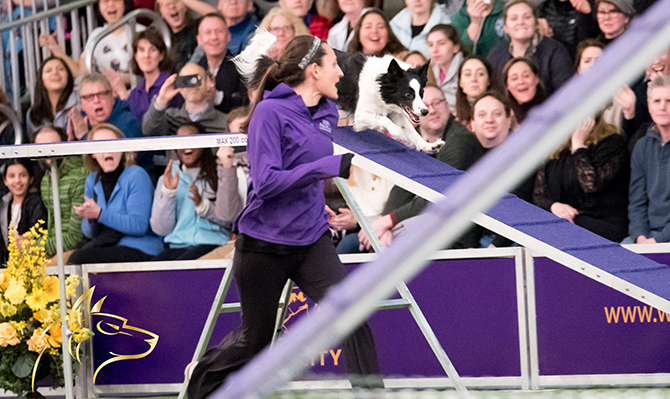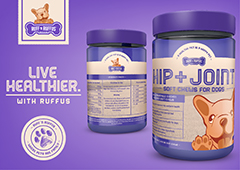AGILITY TRAINING FOR YOUR DOG
A PHYSICAL AND MENTAL WORKOUT
 ©1TDC.com
©1TDC.comBy Jessica Ajoux
It’s just like horses, but it’s dogs!” That is what Jessica Ajoux, co-founder and co-owner of UnitedDog LLC, a premier dog agility training facility located just outside Philadelphia, thought when she first saw dog Agility on TV back in 1998. Little did she know that twenty years laters in 2018, she herself would be on national TV winning the prestigious title of Westminster Kennel Club Masters Agility Champions with her Border Collie FameUS. To further this magical tale, UnitedDog LLC’s other half, Perry DeWitt, took the title the following year in 2019 with her dog Verb.
Similar to equestrian show jumping, agility involves a handler guiding a dog through an obstacle course. As shown by its growing presence in mainstream media, dog agility is the most popular and rapidly growing sport. Dogs of all sizes, breeds, and backgrounds can learn agility, and most can even compete. The dogs love it, the handlers love it, and nothing compares to the partnership and teamwork that develop when a dog and handler work together through the challenges of the course.
Agility is a combination of physical and mental activity. By stimulating and developing these basic needs, this sport proves rewarding and fulfilling to both dogs and their handlers. For the dogs, Agility training allows them to engage their brains by learning to problem solve and to follow and respond to directions while running at top speed. For people, Agility is a puzzle that is intriguing to solve. While the actual obstacles do not vary, the combination of those obstacles, the “course,” is different every time. This means that the handler must strategize and figure out the best path for his dog to take and how to best communicate those directions to the dog. As a UnitedDog student put it; ‘Agility keeps me motivated to stay physically active and mentally sharp, I want to be the best for my dog!” People never get bored from agility and neither do the dogs.
While adequate exercise is crucial for a dog’s well-being, Agility pushes beyond the regular day to day canine activities. Agility, as its name implies, is a physical sport and so can be demanding on a dog’s body. To keep the dogs feeling their best throughout training and competition, the UnitedDog agility dogs are properly conditioned, receive regular therapeutic treatment and are protected with a daily dose of 1-TDC, a fantastic unique daily supplement that promotes joint health and performance recovery.
 ©1TDC.com
©1TDC.comAgility is a good fit for dogs with high energy levels or dogs who need more activity to keep them satisfied. Agility can also be very therapeutic for dogs. It can help shy dogs develop confidence, as they feel empowered by learning new things and overcoming challenges. Finally, agility is a great way to increase the bond between an owner and his or her dog since it revolves around the human and dog working together.
Though now top level competitors and trainers, Jessica and Perry started out agility “just for fun” with their pet dogs. Even if you have no plan compete, or even any access to training clubs or equipment, you can start to train for agility.
Here are some simple and fun foundation exercises that can be started right away and that might help you gauge your level of interest in agility as well as your dog’s. Remember, training is a process! Dogs do not instantly “get it”… they have to learn. Your goal is to help them figure out what you are trying to have them accomplish. Before you even start training, you need to figure out what motivates your dog. In other words, what your dog likes. This is the reward that you will use to help entice him and reward him for his efforts. The dog should never feel discourage while learning. Keep the tasks manageable in order for him to feel motivated, successful, engaged, and good about the learning process. Short training sessions, 5-10 minutes are ideal.
1. Going around a cone/anything
Teach your dog to move out and around an object. It can be a traffic cone, a trash can, a chair, a tree…get creative! This simulates the dog going “towards an obstacle” and then coming back to you. It also help them learn to coordinate their body and bend in order to achieve a tight turn.
2. Climbing on different surfaces
Some of the Agility obstacles require the dog to climb up, over and across. The See-saw even moves! This can be frightening to dogs. Help them develop confidence by having them climb on a variety of different textures and surfaces. Received a big order from Amazon? Teach your dog to climb on and in that big cardboard box. Have them walk across storage bin lids, pillows, or suitcases. Again, be creative. Remember for this exercise that if your dog becomes scared, never force him! Take your time and gradually up the ante. The confidence will build within the dog.
3. Weaving between the legs
In preparing for the weave poles, you can teach your dog to weave between your legs. Use a treat to help lead the dog through your legs as you take gradual steps forward. This is great for developing a dog’s coordination and flexibility.
As shown through their repeated high level accomplishments, UnitedDog is doing something right in the Agility world. Their training methodologies and teachings are are based on clear communication between the dog and the handler. They love every aspect of agility from the sport, to the training, the learning and the teaching. Agility makes sense to dogs and when learning agility, the handler is as much the dog’s teacher as he is the dog’s student. UnitedDog believes that it is important to listen to what your dog is telling you when embarking on your dog agility training journey.







